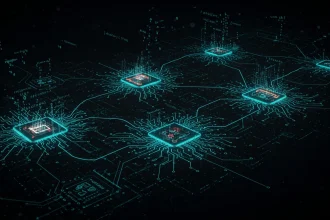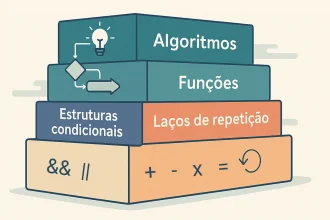Introduction: Building the Foundations of the Online World
At the heart of our daily digital experience lies WEB Development. Whether browsing a news website, shopping in an online store, or interacting on a social network, everything we see and interact with on the internet is the result of the work of web developers. This dynamic and constantly evolving field is responsible for bringing online ideas to life, transforming concepts into visual interfaces and interactive functionalities that shape the way we access information, communicate, and conduct transactions in the digital world.
Therefore, for anyone who aims to understand the workings of the internet behind the visual curtains or who wants to start a promising career in the technology field, familiarity with the fundamentals of WEB Development is essential. This article has been carefully crafted for you, the beginner, seeking to demystify this crucial field and understand the pillars that underpin the construction of the online world.
Unveiling the Concept: What Exactly is WEB Development?
At its core, WEB Development is the process of creating, building, and maintaining websites and applications that run on the internet (the World Wide Web) or on a private network (an intranet). It involves a variety of tasks, from the markup and design of the user interface to the programming of server-side functionalities and the management of databases. The ultimate goal is to create accessible, usable, efficient online experiences that meet the objectives of their creators and users.
Thus, WEB Development is a multidisciplinary field that combines skills in design, programming, usability, and web optimization. It encompasses both the visual and interactive part with which users directly interact (the front-end) and the logic behind this interface, which processes data and manages the functioning of the system (the back-end).
The Pillars of Digital Construction: The Fundamental Languages of WEB Development
The construction of any web page or application is based on some fundamental languages:
1. HTML (HyperText Markup Language): Firstly, HTML is the backbone of any web page. It provides the structure and content of the page, using markups (tags) to define elements such as texts, images, links, forms, and other components. Think of HTML as the skeleton of the page.
2. CSS (Cascading Style Sheets): Secondly, CSS is responsible for the visual presentation of the page. It defines the style of the HTML elements, including colors, fonts, layouts, spacings, and responsiveness (adaptation to different devices). CSS is like the clothing and aesthetics of the page.
3. JavaScript (JS): Additionally, JavaScript adds interactivity and dynamism to web pages. It allows you to manipulate HTML and CSS in real time, respond to user events, make requests to servers, and create rich and interactive experiences. JavaScript is the behavior and interactivity of the page.
The Division of Labor: Front-End vs. Back-End
WEB Development is generally divided into two major areas:
1. Front-End Development: Firstly, front-end development (or “client-side”) focuses on the visual and interactive part of the website or application with which users directly interact. Front-end developers primarily use HTML, CSS, and JavaScript to build the user interface, ensuring it is attractive, responsive, and functional across different browsers and devices. They also concern themselves with user experience (UX) and user interface (UI).
2. Back-End Development: Secondly, back-end development (or “server-side”) deals with the logic behind the user interface. It involves programming the server, managing databases, creating APIs (Application Programming Interfaces), and ensuring that the system functions correctly and securely. Back-end developers use various programming languages (such as Python, Java, PHP, Ruby, Node.js) and database management systems (such as MySQL, PostgreSQL, MongoDB).
It is important to note that some professionals work in both areas, being called “full-stack” developers.
The Creation Lifecycle: Typical Stages of WEB Development
The WEB Development process generally involves the following stages:
1. Planning: Firstly, defining the objectives of the website or application, identifying the target audience, analyzing the competition, and creating a project plan.
2. Design: Secondly, creating the visual design of the user interface, usually using graphic design and prototyping tools.
3. Front-End Development: Additionally, building the HTML structure, styling with CSS, and adding interactivity with JavaScript, following the defined design.
4. Back-End Development: Furthermore, programming the server logic, creating the database, and developing the necessary APIs for communication with the front-end.
5. Testing: Finally, conducting tests on different browsers and devices to ensure the functionality, usability, and responsiveness of the website or application.
6. Deployment: Publishing the website or application on a server so that it can be accessed by users.
7. Maintenance: Performing updates, bug fixes, and continuous improvements to the website or application.
The Developer’s Toolkit: Essential WEB Development Technologies and Frameworks
The WEB Development ecosystem is vast and includes various technologies and frameworks that facilitate the work of developers:
Front-End:
- CSS Frameworks: Bootstrap, Tailwind CSS (make it easier to create responsive and styled layouts).
- JavaScript Libraries: jQuery, React, Angular, Vue.js (provide structures and tools to build complex and interactive interfaces).
- CSS Preprocessors: Sass, Less (extend the functionality of CSS).
- Package Managers: npm, Yarn (manage project dependencies JavaScript).
Back-End:
- Programming Languages: Python (with frameworks like Django and Flask), Java (with Spring), PHP (with Laravel and Symfony), Ruby (with Rails), Node.js (with Express).
- Database Management Systems (DBMS): MySQL, PostgreSQL, MongoDB.
- Web Servers: Apache, Nginx.
- API Tools: RESTful APIs, GraphQL.
Development Tools:
- Code Editors: VS Code, Sublime Text, Atom.
- Browser DevTools: Integrated tools in browsers to inspect and debug code.
- Version Control Systems: Git, GitHub, GitLab.
Taking the First Steps: How to Get Started in WEB Development
If you are a beginner interested in learning WEB Development, here are the first steps you can take:
1. Learn HTML: Start by learning the fundamentals of HTML, understanding the basic structure of an HTML document and the main tags for creating content.
2. Learn CSS: Next, learn CSS to style your HTML documents, controlling the appearance of elements and creating attractive visual layouts.
3. Learn JavaScript: Additionally, familiarize yourself with the basic concepts of JavaScript to add interactivity to your web pages.
4. Choose a Focus Area (Front-End or Back-End): While it’s interesting to have an overview of both areas, choosing an initial focus can make your learning easier.
5. Explore Frameworks and Libraries: After mastering the fundamentals, start exploring popular frameworks and libraries in your area of focus to streamline development.
6. Practice with Personal Projects: The best way to learn is by practicing. Start with simple projects and gradually move to more complex challenges.
7. Utilize Online Resources: There are countless free and paid online resources for learning WEB Development, such as tutorials, courses, documentation, and communities.
8. Join Communities: Join forums, discussion groups, and online communities of developers to exchange knowledge, ask questions, and network.
9. Build a Portfolio: As you develop your projects, create an online portfolio to showcase your skills and work.
10. Stay Updated: The world of WEB Development is constantly evolving. Dedicate time to learn new technologies and trends.
The Power of Collaboration: Teamwork in WEB Development
Large WEB Development projects usually involve multidisciplinary teams, including designers, front-end developers, back-end developers, project managers, and testers. Effective collaboration is crucial for the success of these projects, using communication tools, version control systems, and development methodologies (such as Agile and Scrum) to ensure that everyone works together efficiently.
The Future of the Web: Trends and Innovations in WEB Development
WEB Development is a dynamic field with several emerging trends:
- Responsive Web and Mobile-First: Prioritizing the creation of websites and applications that adapt to different screen sizes and mobile devices.
- Progressive Web Apps (PWAs): Web applications that offer a native app-like experience, with features like installation on the home screen and push notifications.
- Single-Page Applications (SPAs): Web applications that load a single HTML page and dynamically update content, providing a more fluid user experience.
- Serverless Development: The use of cloud services that abstract server management, allowing developers to focus on code.
- Artificial Intelligence (AI) and Machine Learning (ML) on the Web: The integration of AI and ML functionalities into web applications for personalization, data analysis, and other tasks.
- Virtual Reality (VR) and Augmented Reality (AR) on the Web: The development of immersive experiences directly in browsers.
- WebAssembly (Wasm): A technology that allows running code in other languages (besides JavaScript) in browsers, improving performance.
Conclusion: Exploring the Universe of Online Construction
WEB Development is a vast and exciting field that offers countless opportunities for those who want to build the future of the internet. For beginners, learning the fundamentals of HTML, CSS, and JavaScript is the essential starting point for unraveling the digital web and starting to create your own web pages and applications.
Remember that the learning journey in WEB Development is continuous. As you gain knowledge and experience, explore new technologies, frameworks, and trends to expand your skills and stay relevant in this constantly evolving market. With dedication, practice, and a passion for digital creation, you can build a promising future in the world of WEB Development.
Therefore, do not hesitate to take the first step and start exploring the infinite possibilities of online construction. The digital universe awaits your creations!









